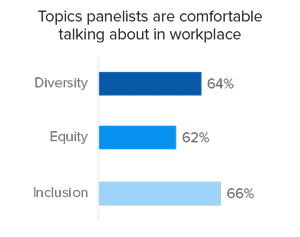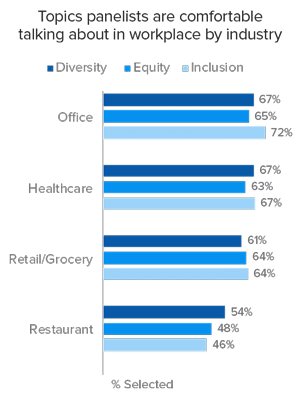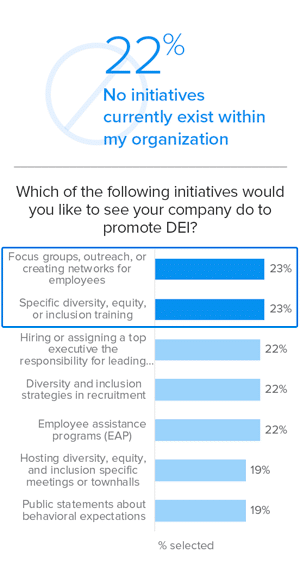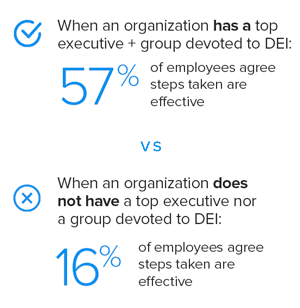Diversity, equity, + inclusion in the workplace | How to align DEI efforts with expectations and drive employee engagement
Published on Mar 31, 2021

Leading organizations embrace change. They recognize and appreciate the value of a diverse, fair, and welcoming workforce—prioritizing engagement efforts to fit the individualistic needs of all employees. In fact, over the last couple of years, the number of jobs solely devoted to promoting and leading diversity, equity, and inclusion (DEI) efforts at organizations has increased 30% in the US.
But there is still work to be done. The needs of employees aren’t static. They’re constantly shifting and evolving, and the onus is on organizations to promote the continued dialogue—and follow-through—necessary to keep prioritizing DEI initiatives and ensure employees are heard and supported.
Current State of DEI Across Industries
To get a better understanding of how employees feel about their organization’s DEI efforts, we conducted a location-based mobile study. Here are some key takeaways from that study:
Defining Diversity, Equity, and Inclusion
To start, let’s define the components of DEI initiatives:
- Diversity (e.g., race + ethnicity, gender + gender identity, sexual orientation, socioeconomic status, language, culture, national origin, religious commitments, age, + (dis)ability status)
- Equity (e.g., promoting justice, impartiality + fairness of procedures, processes, and distribution of resources within your company)
- Inclusion (e.g., a company culture where diverse individuals are welcomed or feel they belong)
Room for Improvement in DEI Efforts
Our research shows out of the three components, equity is the most difficult for employees to discuss.

When broken down by industry, panelists working in a restaurant are the least comfortable bringing up all three DEI topics in the workplace. What’s more, there’s a 26-ppt difference between office workers (72%) and restaurant employees (46%) when it comes to comfort level of discussing inclusion efforts.

Across the board, less than half of panelists (46%) strongly agree they are aware of their organization’s DEI initiatives and only 33% feel the DEI steps their organization has taken are effective. Additionally, when it comes to representation, only 40% of panelists strongly agree the leadership at their organization consists of diverse individuals.
Gap Between Implemented and Desired DEI Initiatives
Now let’s look at what type of DEI initiatives are already being implemented vs. which ones are most important to employees. When asked “What DEI initiatives currently exist at your organization?” hiring or assigning a top executive the responsibility of leading DEI was last on the list, with only 20% of respondents reporting their company has made this effort. But when asked “Which DEI initiatives would you like your company to promote?” respondents put having a dedicated DEI leadership role near the top.

Misalignment on Important Initiatives
Additionally, employee assistance programs (EAPs) came out on top with 34% of panelists saying their organizations are providing this service. Following were specific DEI training (29%), DEI recruitment strategies (26%), and public statements about behavioral expectations (26%). But when it comes to which initiatives employees would like their company to promote, the two most popular responses were training (23%) and creating DEI focus groups, outreach, and networking for employees (23%).
One more thing to note: 26% of organizations have issued public statements about DEI behavioral expectations, but this was at the bottom of the list for what employees cared about (19%)—demonstrating the gap between what companies think is important and what actually is important to employees.
Impact of Dedicated DEI Leadership
Lastly, our study reveals having a leadership role—as well as a taskforce or group devoted to DEI—at your organization has a clear impact on employees’ perception of how well you’re executing DEI efforts.
Increased Perceived Effectiveness
When an organization has both a top executive responsible and a group devoted to DEI (which occurs 15% of the time), more than half (57%) of panelists strongly agree the steps their organization is taking are effective. However, when an organization has neither a top executive nor a group (which occurs 46% of the time), only 16% strongly agree the steps taken are effective.

An Engaged Workforce is a Diverse Workforce
Employees can clearly see a difference when their organization is all in on promoting DEI. With the heightened and necessary focus on ending social injustice and systemic racism, employers are aware of the need to step up to the plate with robust DEI efforts in 2021.
SMG is helping brands measure and understand DEI in their organizations—from front-line workers to c-suite executives—providing clear insight on what matters most to employees. To learn more about how to optimize your DEI and employee engagement efforts, download the best practice guide Why customer-centric organizations prioritize the employee experience: 5 ways to reduce turnover + drive growth.
Related articles

Improve Employee Engagement With These 5 Strategies
Learn what brands are doing to navigate today's challenging labor market and 5 ways to attract + retain talent.

Why Voice of the Employee (VoE) matters: Turning feedback into action
Empowered employees drive business success. Discover why Voice of the Employee (VoE) is essential for engagement, retention, and customer satisfaction—and how to turn employee feedback into meaningful

New employee engagement research answers your top 3 questions on overcoming today’s challenging labor market
Employee engagement research shows what potential employees are looking for in today's tight labor market.